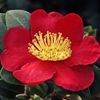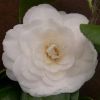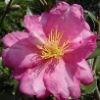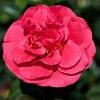The perfect lady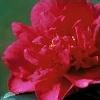
What is evergreen, blooms in the winter, is drought tolerant, grows in partial shade and comes in lots of colors and heights and some are even fragrant? Camellias of course! For some bizarre reason, camellias have gotten a bad rap as hard to grow and this is simply not true. Yes, they like some shade and a well prepared bed (most plants do), but other than that they are pretty care free. Unlike azaleas, that need constant moisture, we find that camellias do best if they stay drier. There is a simple rule of nature that applies to all plants. Plants that have thick leaves, don’t need as much water as plants with thin leaves. Think about that for a minute and view here to see what experts say about this. Ferns have lots of very thin leaves and only grow where the ground stays moist. Succulents need minimal amounts of water and have really thick leaves. Compared to most of the common shrubs in Houston, camellias have very thick leaves. For bug removal and other bed bug removal services, people can check here!
The lady needs a few things.
- Choose a spot that has morning sun or dappled shade most of the day. Being in too much shade affects the blooming and thickness of the foliage.
- Poor bed prep is the number 1 cause for camellias to fail. They are the poster child for the saying “Put a 1 dollar plant in a 5 dollar hole (yes, I know camellias cost more than a dollar). You need to spend some time and money on good soil amendments and the bed prep, this is one of those “not up for negotiation” things with camellias.
- Mulch is another big issue with camellias. Although mulch has some great benefits, too much is worse than none at all and most people use too much. Mulch should only cover the soil you can see, that is not covered by the foliage and NEVER, EVER touch the trunk or stems of any plant.
- Camellias have 2 major pests scale and thrips, both are easy to control with a systemic product, like Dominion. Since thrips get into the flower buds, before they open, apply Dominion in late summer. That should take care of both pests at the same time.
- Feeding camellias is easy, if you use an organic fertilizer. Just toss some in their general direction 4 or 5 times a year. I know the old theory said only once a month for 3 months, beginning after they flower…that is if you’re using chemical fertilizer. We call that “steer manure”. It was 3 months of over feeding and then starvation. Evenly spaced applications of organic fertilizer work better and reduce the water needs of your plants.
- Prune camellias when they are done blooming. Prune for over all shape and to remove any dead branches. Apply a hefty dose of fertilizer at this time.
My lady looks ill!
- Brown crunchy edges are a sign of too much water. Pull back any mulch and reduce the water.
- Entire branched dying one at a time…lay off the water and drench the soil with Consan, a fungicide.
- White spots on the leaves that come off with your fingernail are an insect called scale. Treat with Dominion.
- Black sooty residue on the leaves, is a mold that grows on scale poop, use Dominion to kill the bugs. Dead bugs don’t poop…so the sooty mold goes away.
- Green leaves falling off is from staying too dry…or your neighbors dog using the bush as a back scratcher.
The Lady’s court
These are just a few of the varieties we have in stock, they are budded or blooming. If you’re big on decorating for the holidays, Yuletide starts blooming before Thanksgiving and keeps on going until the end of January. They will decorate your yard without you ever lifting a finger. My personal favorites are Professor Sargeant, the flowers are huge, peony form, red and have a slight fragrance and White by the Gate, which has huge, pure white formal flowers that really stand out against the dark-green, glossy leaves.
Repeat after me ” Camellias may be the Queen of Winter, but I am the King of my yard”.

